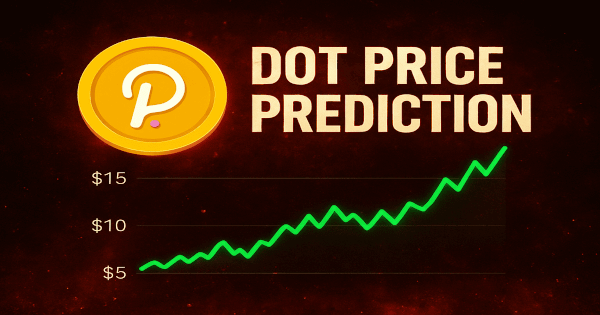DOT Price Prediction: $2.75-$3.30 Recovery Target by December 2025
Jessie A Ellis Nov 27, 2025 15:14
Polkadot trades near oversold levels at $2.33 with analyst consensus pointing to $2.75-$3.30 recovery targets within 4-6 weeks as technical indicators suggest potential reversal.

Polkadot (DOT) has found itself at a critical juncture, trading at $2.33 and hovering dangerously close to its 52-week low of $2.26. With multiple analysts weighing in on DOT's near-term prospects, the consensus points toward a potential recovery rally that could push prices toward the $2.75-$3.30 range within the next month.
DOT Price Prediction Summary
• DOT short-term target (1 week): $2.45-$2.60 (+5-12%) • Polkadot medium-term forecast (1 month): $2.75-$3.30 range (+18-42%) • Key level to break for bullish continuation: $2.75 resistance • Critical support if bearish: $2.18 immediate support, $2.03 Bollinger lower band
Recent Polkadot Price Predictions from Analysts
The recent wave of analyst predictions reveals a remarkable consensus around DOT's oversold conditions and potential for a short-term bounce. Multiple sources, including Blockchain.News, MEXC News, and Rich by Coin, have identified the $2.75-$3.30 corridor as the primary DOT price target for the coming weeks.
Blockchain.News specifically highlighted DOT's RSI reading of 30.27 in their November 26th analysis, suggesting oversold conditions that typically precede relief rallies. This technical observation aligns with our current RSI reading of 34.59, which while slightly higher, still indicates potential upside momentum.
The most aggressive Polkadot forecast comes from XT Blog's identification of a falling wedge pattern on the weekly chart, projecting a long-term DOT price target of $16.00. However, this prediction carries low confidence given the significant technical hurdles that would need to be overcome.
DOT Technical Analysis: Setting Up for Recovery
The current Polkadot technical analysis reveals several indicators pointing toward an oversold bounce scenario. DOT's position at $2.33 represents just 3% above its 52-week low, creating a compelling risk-reward setup for potential buyers.
The RSI reading of 34.59 sits in neutral territory but has been trending lower, suggesting selling pressure may be exhausting. More importantly, the Stochastic indicators show %K at 19.66 and %D at 17.12, both deep in oversold territory and potentially setting up for a bullish crossover.
DOT's position relative to the Bollinger Bands tells an interesting story. With the current price sitting at just 0.22 position between the bands, Polkadot is trading much closer to the lower band ($2.03) than the middle band ($2.69), indicating oversold conditions that often precede mean reversion moves.
The MACD histogram at -0.0244 shows bearish momentum is slowing, though it hasn't yet turned positive. This suggests that while selling pressure remains, it's losing steam and could reverse in the coming sessions.
Polkadot Price Targets: Bull and Bear Scenarios
Bullish Case for DOT
The primary bullish DOT price target focuses on the $2.75-$3.30 range, supported by multiple resistance levels and analyst consensus. The first major hurdle comes at the 20-period SMA of $2.69, which aligns closely with the Bollinger Band middle line and represents initial resistance.
If DOT can reclaim $2.75, the next Polkadot forecast target becomes $3.30, which coincides with several analysts' projections and represents the lower boundary of the Bollinger upper band at $3.36. This level also aligns with previous support that could now act as resistance.
For the bullish case to play out, DOT needs to see increased volume above the current $11.4 million daily average and a decisive break above the 7-period SMA of $2.32, which is currently acting as immediate resistance.
Bearish Risk for Polkadot
The bearish scenario for this DOT price prediction centers around a break below the critical $2.18 immediate support level. Such a move would likely trigger stops and could push Polkadot toward the Bollinger lower band at $2.03.
More concerning would be a breakdown below the 52-week low of $2.26, which could signal a continuation of the broader downtrend and potentially target the strong support level at $0.63, though this represents an extreme downside scenario with low probability in the near term.
Risk factors include continued weak volume, failure to break above the 20-period SMA, and any broader crypto market weakness that could pressure DOT regardless of its technical setup.
Should You Buy DOT Now? Entry Strategy
Based on the current Polkadot technical analysis, a staged entry approach appears most prudent. The ideal buy DOT strategy involves establishing initial positions near current levels ($2.30-$2.35) with additional accumulation planned if DOT tests the $2.18 support.
Stop-loss levels should be set below $2.03 (the Bollinger lower band) to limit downside risk while allowing for normal volatility. This provides roughly 12-15% downside protection while targeting 18-42% upside potential to the $2.75-$3.30 range.
Position sizing should remain conservative given the overall weak trend, with no more than 2-3% portfolio allocation recommended. Consider dollar-cost averaging over 2-3 weeks rather than committing full position size immediately.
DOT Price Prediction Conclusion
The DOT price prediction for the next 4-6 weeks points toward a recovery rally targeting $2.75-$3.30, representing 18-42% upside potential from current levels. This forecast carries medium confidence based on oversold technical indicators, analyst consensus, and proximity to established support levels.
Key indicators to monitor for confirmation include RSI moving above 40, MACD histogram turning positive, and most importantly, a decisive break above $2.75 with increased volume. Invalidation of this bullish Polkadot forecast would occur on a break below $2.18 with follow-through selling.
The timeline for this DOT price prediction to materialize spans December 2025, with initial moves potentially occurring within the next 7-10 trading days if technical momentum continues to build. Traders should remain vigilant for volume confirmation and be prepared to adjust positions based on broader market conditions.
Image source: Shutterstock.jpg)